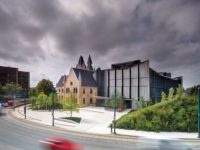Novartis Campus
East Hanover, New Jersey
Surprising what you can do with a box. In designing Novartis's corporate global oncology offices on its East Hanover, New Jersey, campus, New York architects Weiss/Manfredi took the master plan's rectilinear form, 275 feet long, 100 feet wide and 75 feet high, and began carving up spaces inside and out. Each of the four elevations varies from the other by virtue of voids surgically cut into the glazed volume: one shelters a grand entrance stair on the northwest corner; one major incision creates an outdoor balcony on the fourth floor at the north end; another does the same for the third level at the south end; while yet a third balcony appears on the west side at the second level. Expanses of clear glass seemingly set in shallow relief within the patterned curtain wall express the program where the run of stairs connect the levels within, including double-height communal spaces known as “living rooms.”
The architects connected the five floors of the 140,000- square-foot building with wide stadium steps and bench seating that lead directly to the spacious living rooms. “We like the whole concept of the communicating stair,” says Dias, who notes that when Novartis was selecting architects, it visited Weiss/Manfredi's Diana Center at Barnard College in New York, where communal spaces cascade down the interior of the multiuse arts building, in parallel with zigzagging stairways. At Novartis, the architects organically integrated steps and sitting areas. “We carved out an ascending spiral in one continuous sweep,” says principal Michael Manfredi about the three flights of stairs that climb the levels along the building's perimeter walls, linking to the three double-height gathering spaces.
In counterpoint to this vertical spiral are the single-story workstations, small “enclave” spaces, and conference rooms, all arranged in and around the central elevator core. “We could have put the core against the perimeter wall, but instead we decided to center it,” says Weiss. “The core became the dictator.” Structural bays, 24 by 30 feet, with an 8-foot module for workstations and a 4-foot one for the curtain wall, impart the clarity and coherence of a Miesian open plan. The core structure also means that workstations are no more than 30 feet from exterior walls, giving occupants daylight and views. Sixteen-inch raised floors allow the workstations to be flexibly configured, contain a sound masking system, and provide air distribution in a ductless pressurized manner that enhances energy efficiency. “Novartis wanted us to meet Basel's energy standards, matching those of its headquarters,” says project manager Clifton Balch.
To encourage more spontaneous interaction among campus employees, the architects installed a handsomely tailored restaurant on the main floor. The bronze pleated panels on the core walls, along with oak ceilings and the earth-toned custom-designed carpets, make you think of a comfortably modern inn. Other features, such as white oak paneling and ceiling slats in the common areas and the red wing chairs designed by Weiss (and now produced by Vitra) in the living rooms, add to the gestalt.
The exterior glazing picks up the residential theme—if in a very abstract manner: “We wanted a soft, inviting curtain wall, which would be another riff on the theme of domesticity,” explains Weiss. The architects brought together three kinds of glass for the curtain wall—acid-etched, reflective, and fritted—to form a subtly quirky pattern of slightly bent vertical striations that admit different levels of light. “We were interested in playfulness and uncertainty, as if we were drawing tree branches on the facade,” says Manfredi. The ethereal effect required numerous drawing studies and mock-ups owing to its complex geometry. Fortunately, the craftsmanship rose to the levels of the intention “to trick the eye” in Manfredi's words—referring, among other things, to the omission of spandrels and other ways of calling out the individual floor plates on the exterior.
Adding to the ambiguity and surreal quality of the curtain wall is the actual structure itself. The architects designed the steel-framed building so that the top half is suspended from the 100-foot-long plate girders that cantilever 30 feet on each side of the roof. Meanwhile, the lower floors follow more conventional perimeter-column and core construction. A void expressed at the third level indicates the split between the top-down and bottom-up structural systems and creates a sense of the upper mass hovering above the lower one.
Because of the placement of the buildings in the master plan, you can apprehend the subtleties of the curtain wall and detailing on all four sides, a benefit obviously more available to an exurban site than the tighter one of an urban situation. And the small plazas and parks in this setting soften the architecture's forthright presence. Yet the office building doesn't try to brazenly stand out. Instead, it complements its neighbors quite judiciously, while maintaining its own elegant identity and strong personality.
People
Contact name and phone number should we have additional questions on credits:
Formal name of building:
Location:
Completion Date:
Gross square footage:
Total construction cost:
Client:
Architect's firm name, address, phone, and fax number:
Personnel in architect's firm who should receive special credit:
Interior designer:
Engineers: MEP/FP/Security: Cosentini Associates
Consultant(s): Lighting: Brandston Partnership, Inc. Food Service: JNDavella Consulting, LLC AV/Acoustics: Shen Milsom & Wilke Elevator Consultant: Van Deusen & Associates Cost Estimator: Davis Langdon (AECOM) Code & Life Safety: Code Consultant Professional Engineers, PC . Waterproofing: James R. Gainfort, AIA Consulting Architects, PC
Construction Manager:
Photographer(s):
© Albert Vecerka/Esto |
Products
Structural system Concrete: Stateline Construction Co., Inc.
Exterior cladding Curtain wall: Permasteelisa North America
Glazing
Doors Revolving Door: Blasi GmbH
Interior finishes Interior acid etched glass: S.A. Bendheim, Ltd. Bronze panel wall: Linel Stone flooring: Vermont Structural Slate Company, Inc. Acid etched glass mosaic wall tile: Artistic Tile Carpet tile: Bentley
Furnishings Custom Chair designed by Weiss/Manfredi: Vitra Custom area rugs: Groundplans, Ltd. Custom conference table: WallGoldfinger, Inc.
Lighting Dimming system and shading controls: Lutron Electronics |
















